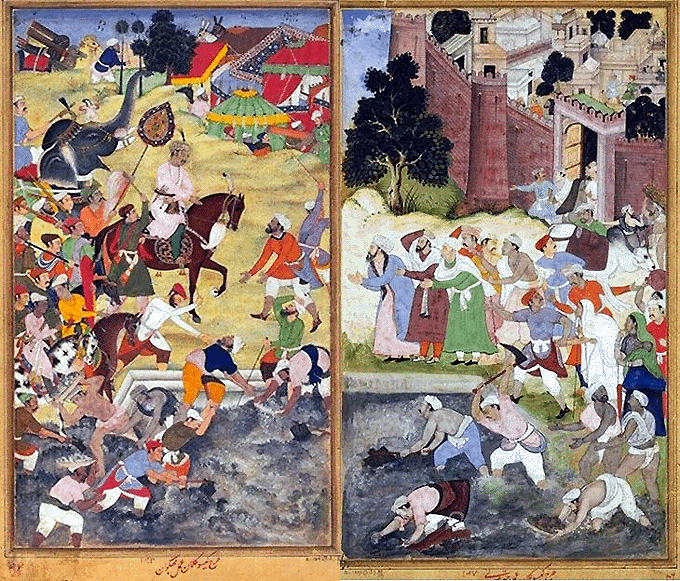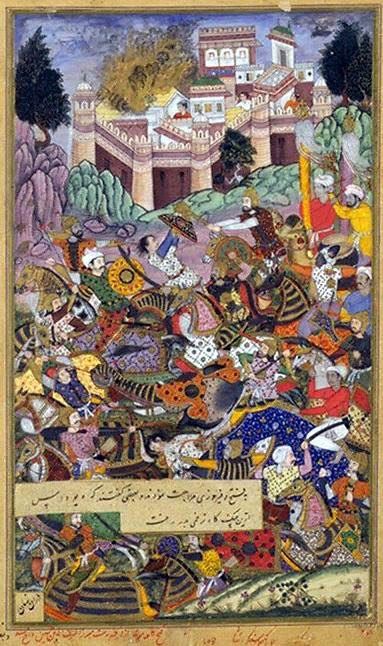The Mughal Influence on Vaisnavism, Part 22
BY: SUN STAFF - 19.2 2019

The Attack on Ranthambhor
Illustrations from Akbar-nama, c. 1577
A serial presentation of the Mughal effect on Vaisnava society.
Today we continue to follow the story of Mughal Emperor Akbar's campaign of destruction in the state of Rajasthan. Following the devastating rout of Chittor fort, in which nearly 40,000 Rajputs and local Hindu citizens lost their lives, Akbar's army went on to assault many other towns, villages, and garrisoned forts.
The assault on Chittor lasted from October 1567 to February 1568 A.D. By the end of 1568, Akbar had concentrated his forces around the fort at Ranthambhor, which was under the rule of Rao Surjan Hada of Bundi. Ranthambhor is located on the northern side of the Malwa Plateau, northeast of Chittor. The region is well known for the Malwa School of art, which has produced a wealth of beautiful Krsna lila paintings. It was in Malwa that Akbar launched preliminary attacks before heading to Chittor.
Ranthambhor fort had been attacked earlier by the Mughals, in 1560, but that army had met defeat at the hands of the Rajputs. To the south, the fort of Gagraun in Bundi had also been captured earlier in the year. With Gagraun and Chittor overtaken, Akbar was free to focus on Ranthambhor.

Surjan Hada's Alliance with Akbar
The Mughals build a network of ramparts and walls on a hill adjacent to the fort, and using teams of bullocks, dragged huge guns into position. Opening fire, they battled fiercely with the Rajputs until the fort commander, Surjan Hada, sent his Rajput generals to negotiate a ceasefire with Akbar's men. Surjan grudgingly accepted an alliance, on the condition that Akbar would not marry any of his daughters. As part of the deal that followed, Surjan Hada was appointed as a Mughal officiary -- a Rao Raja -- and was given a new estate, along with his ancestral kingdom of Bundi.
As the Rajput garrison exited the fort, taking their weapons and goods with them, Surjan Hada removed several Vaisnava deities that had been moved into the fort for safekeeping. He spirited them off to a safe location, so the Mughals could not desecrate them.

Battle outside the Bundi Fort
While the battle depicted above does not appear to be recorded in Mughal or Rajput documents, it is thought to represent an offensive in 1577 led by Surjan Hada, who had eventually Rajasthan, going into exile at Benares. This fight may have taken place after the Battle of Haldighati, in 1576 A.D. The fort of Bundi is seen in the background.

Akbar's visit to Nagaur
One of Surjan Hada's commanders at Chittor was Jaimal Rathore. Prior to the Chittor battle, Jaimal had been the ruler of Merta, a small kingdom near Nagaur and Ajmer in Rajasthan. It was after the fall of Merta that Jaimal departed with his family and followers, taking shelter at the Chittor fort. This was an understandable move for Jaimal, given the long history of alliance between his kingdom at Merta and the prince of Chittor. In fact, the famous Vaisnavai poet Mirabai was the aunt of Jaimal Rathore. She married a Chittor prince, and Jaimal was given an estate at Badnore in exchange for his services on behalf of the Maharana.

Battle at Merta
Akbar's army wreaked havoc all throughout the Rajastani countryside, pillaging many places like Bundi and Merta. Another was Nagaur, near Merta. Akbar appointed his own governor there – the Sultanate of Nagaur. The painting below depicts a visit Akbar made to Nagaur, where the local men were whipped as they cleaned the water tank outside the fort, in a petty show of Akbar's dominion over 'the infidels'.






































